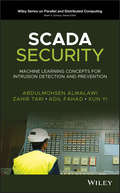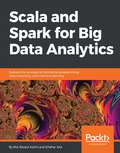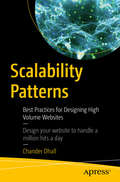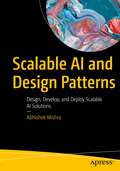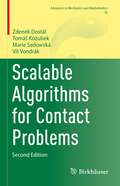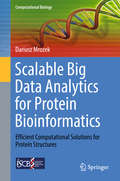- Table View
- List View
SCADA Security: Machine Learning Concepts for Intrusion Detection and Prevention (Wiley Series on Parallel and Distributed Computing)
by Abdulmohsen Almalawi Zahir Tari Adil Fahad Xun YiExamines the design and use of Intrusion Detection Systems (IDS) to secure Supervisory Control and Data Acquisition (SCADA) systems Cyber-attacks on SCADA systems—the control system architecture that uses computers, networked data communications, and graphical user interfaces for high-level process supervisory management—can lead to costly financial consequences or even result in loss of life. Minimizing potential risks and responding to malicious actions requires innovative approaches for monitoring SCADA systems and protecting them from targeted attacks. SCADA Security: Machine Learning Concepts for Intrusion Detection and Prevention is designed to help security and networking professionals develop and deploy accurate and effective Intrusion Detection Systems (IDS) for SCADA systems that leverage autonomous machine learning. Providing expert insights, practical advice, and up-to-date coverage of developments in SCADA security, this authoritative guide presents a new approach for efficient unsupervised IDS driven by SCADA-specific data. Organized into eight in-depth chapters, the text first discusses how traditional IT attacks can also be possible against SCADA, and describes essential SCADA concepts, systems, architectures, and main components. Following chapters introduce various SCADA security frameworks and approaches, including evaluating security with virtualization-based SCADAVT, using SDAD to extract proximity-based detection, finding a global and efficient anomaly threshold with GATUD, and more. This important book: Provides diverse perspectives on establishing an efficient IDS approach that can be implemented in SCADA systems Describes the relationship between main components and three generations of SCADA systems Explains the classification of a SCADA IDS based on its architecture and implementation Surveys the current literature in the field and suggests possible directions for future research SCADA Security: Machine Learning Concepts for Intrusion Detection and Prevention is a must-read for all SCADA security and networking researchers, engineers, system architects, developers, managers, lecturers, and other SCADA security industry practitioners.
Scala: An Introduction to the Programming Language (Lecture Notes in Computer Science #9980)
by Vicenç TorraThis book gives an introduction to the programming language Scala. It presents it from a functional programming perspective. The book explains with detail functional programming and recursivity, and includes chapters on lazy and eager evaluation, streams, higher-order functions (including map, fold, reduce, and aggregate), and algebraic data types. The book also describes the object-oriented aspects of Scala, as they are a fundamental part of the language. In addition, the book includes a chapter on parallelism in Scala, giving an overview of the actor model.
Scala and Spark for Big Data Analytics: Explore the concepts of functional programming, data streaming, and machine learning
by Md. Rezaul Karim Sridhar AllaHarness the power of Scala to program Spark and analyze tonnes of data in the blink of an eye! About This Book • Learn Scala's sophisticated type system that combines Functional Programming and object-oriented concepts • Work on a wide array of applications, from simple batch jobs to stream processing and machine learning • Explore the most common as well as some complex use-cases to perform large-scale data analysis with Spark Who This Book Is For Anyone who wishes to learn how to perform data analysis by harnessing the power of Spark will find this book extremely useful. No knowledge of Spark or Scala is assumed, although prior programming experience (especially with other JVM languages) will be useful to pick up concepts quicker. What You Will Learn • Understand object-oriented & functional programming concepts of Scala • In-depth understanding of Scala collection APIs • Work with RDD and DataFrame to learn Spark's core abstractions • Analysing structured and unstructured data using SparkSQL and GraphX • Scalable and fault-tolerant streaming application development using Spark structured streaming • Learn machine-learning best practices for classification, regression, dimensionality reduction, and recommendation system to build predictive models with widely used algorithms in Spark MLlib & ML • Build clustering models to cluster a vast amount of data • Understand tuning, debugging, and monitoring Spark applications • Deploy Spark applications on real clusters in Standalone, Mesos, and YARN In Detail Scala has been observing wide adoption over the past few years, especially in the field of data science and analytics. Spark, built on Scala, has gained a lot of recognition and is being used widely in productions. Thus, if you want to leverage the power of Scala and Spark to make sense of big data, this book is for you. The first part introduces you to Scala, helping you understand the object-oriented and functional programming concepts needed for Spark application development. It then moves on to Spark to cover the basic abstractions using RDD and DataFrame. This will help you develop scalable and fault-tolerant streaming applications by analyzing structured and unstructured data using SparkSQL, GraphX, and Spark structured streaming. Finally, the book moves on to some advanced topics, such as monitoring, configuration, debugging, testing, and deployment. You will also learn how to develop Spark applications using SparkR and PySpark APIs, interactive data analytics using Zeppelin, and in-memory data processing with Alluxio. By the end of this book, you will have a thorough understanding of Spark, and you will be able to perform full-stack data analytics with a feel that no amount of data is too big. Style and approach Filled with practical examples and use cases, this book will hot only help you get up and running with Spark, but will also take you farther down the road to becoming a data scientist.
Scala Data Analysis Cookbook
by Arun ManivannanNavigate the world of data analysis, visualization, and machine learning with over 100 hands-on Scala recipes About This Book • Implement Scala in your data analysis using features from Spark, Breeze, and Zeppelin • Scale up your data anlytics infrastructure with practical recipes for Scala machine learning • Recipes for every stage of the data analysis process, from reading and collecting data to distributed analytics Who This Book Is For This book shows data scientists and analysts how to leverage their existing knowledge of Scala for quality and scalable data analysis. What You Will Learn • Familiarize and set up the Breeze and Spark libraries and use data structures • Import data from a host of possible sources and create dataframes from CSV • Clean, validate and transform data using Scala to pre-process numerical and string data • Integrate quintessential machine learning algorithms using Scala stack • Bundle and scale up Spark jobs by deploying them into a variety of cluster managers • Run streaming and graph analytics in Spark to visualize data, enabling exploratory analysis In Detail This book will introduce you to the most popular Scala tools, libraries, and frameworks through practical recipes around loading, manipulating, and preparing your data. It will also help you explore and make sense of your data using stunning and insightfulvisualizations, and machine learning toolkits. Starting with introductory recipes on utilizing the Breeze and Spark libraries, get to grips withhow to import data from a host of possible sources and how to pre-process numerical, string, and date data. Next, you'll get an understanding of concepts that will help you visualize data using the Apache Zeppelin and Bokeh bindings in Scala, enabling exploratory data analysis. iscover how to program quintessential machine learning algorithms using Spark ML library. Work through steps to scale your machine learning models and deploy them into a standalone cluster, EC2, YARN, and Mesos. Finally dip into the powerful options presented by Spark Streaming, and machine learning for streaming data, as well as utilizing Spark GraphX. Style and approach This book contains a rich set of recipes that covers the full spectrum of interesting data analysis tasks and will help you revolutionize your data analysis skills using Scala and Spark.
Scala Design Patterns: Patterns for Practical Reuse and Design
by John HuntScala is a new and exciting programming language that is a hybrid between object oriented languages such as Java and functional languages such as Haskell. As such it has its own programming idioms and development styles.Scala Design Patterns looks at how code reuse can be successfully achieved in Scala. A major aspect of this is the reinterpretation of the original Gang of Four design patterns in terms of Scala and its language structures (that is the use of Traits, Classes, Objects and Functions). It includes an exploration of functional design patterns and considers how these can be interpreted in Scala's uniquely hybrid style.A key aspect of the book is the many code examples that accompany each design pattern, allowing the reader to understand not just the design pattern but also to explore powerful and flexible Scala language features. Including numerous source code examples, this book will be of value to professionals and practitioners working in the field of software engineering.
Scala Design Patterns: Design Modular, Clean, And Scalable Applications By Applying Proven Design Patterns In Scala, 2nd Edition
by Ivan NikolovScala Design Patterns, Second Edition: Design Modular, Clean, And Scalable Applications By Applying Proven Design Patterns In Scala, 2nd Edition
by Ivan NikolovDesign patterns make developers’ lives easier by helping them write great software that is easy to maintain, runs efficiently, and is valuable to the company or people concerned. In this book, you’ll learn about the various features of Scala and will be able to apply well-known, industry-proven design patterns in your work.
Scala for Java Developers
by Thomas AlexandreThis step-by-step guide is full of easy-to-follow code taken from real-world examples explaining the migration and integration of Scala in a Java project. If you are a Java developer or a Java architect, working in Java EE-based solutions and want to start using Scala in your daily programming, this book is ideal for you. This book will get you up and running quickly by adopting a pragmatic approach with real-world code samples. No prior knowledge of Scala is required.
Scala for Java Developers: A Practical Primer
by Toby WestonMaster the fundamentals of Scala and understand its emphasis on functional programming that sets it apart from Java. This book will help you translate what you already know in Java to Scala to start your functional programming journey. Learn Scala is split into four parts: a tour of Scala, a comparison between Java and Scala, Scala-specific features and functional programming idioms, and finally a discussion about adopting Scala in existing Java teams and legacy projects. After reading and using this tutorial, you'll come away with the skills in Scala to kick-start your productivity with this growing popular language. What You'll Learn Tour Scala and learn the basic syntax, constructs, and how to use the REPLTranslate Java syntax that you already know into ScalaLearn what Scala offers over and above JavaBecome familiar with functional programming concepts and idiomsGain tips and advice useful when transitioning existing Java projects to Scala Who This Book Is For Java developers looking to transition to Scala. No prior experience necessary in Scala.
Scala for Machine Learning
by Patrick R. NicolasAre you curious about AI? All you need is a good understanding of the Scala programming language, a basic knowledge of statistics, a keen interest in Big Data processing, and this book!
Scala for Machine Learning - Second Edition: Data processing, ML algorithms, smart analytics, and more
by Patrick R. NicolasLeverage Scala and Machine Learning to study and construct systems that can learn from data About This Book • Explore a broad variety of data processing, machine learning, and genetic algorithms through diagrams, mathematical formulation, and updated source code in Scala • Take your expertise in Scala programming to the next level by creating and customizing AI applications • Experiment with different techniques and evaluate their benefits and limitations using real-world applications in a tutorial style Who This Book Is For If you're a data scientist or a data analyst with a fundamental knowledge of Scala who wants to learn and implement various Machine learning techniques, this book is for you. All you need is a good understanding of the Scala programming language, a basic knowledge of statistics, a keen interest in Big Data processing, and this book! What You Will Learn • Build dynamic workflows for scientific computing • Leverage open source libraries to extract patterns from time series • Write your own classification, clustering, or evolutionary algorithm • Perform relative performance tuning and evaluation of Spark • Master probabilistic models for sequential data • Experiment with advanced techniques such as regularization and kernelization • Dive into neural networks and some deep learning architecture • Apply some basic multiarm-bandit algorithms • Solve big data problems with Scala parallel collections, Akka actors, and Apache Spark clusters • Apply key learning strategies to a technical analysis of financial markets In Detail The discovery of information through data clustering and classification is becoming a key differentiator for competitive organizations. Machine learning applications are everywhere, from self-driving cars, engineering design, logistics, manufacturing, and trading strategies, to detection of genetic anomalies. The book is your one stop guide that introduces you to the functional capabilities of the Scala programming language that are critical to the creation of machine learning algorithms such as dependency injection and implicits. You start by learning data preprocessing and filtering techniques. Following this, you'll move on to unsupervised learning techniques such as clustering and dimension reduction, followed by probabilistic graphical models such as Naive Bayes, hidden Markov models and Monte Carlo inference. Further, it covers the discriminative algorithms such as linear, logistic regression with regularization, kernelization, support vector machines, neural networks, and deep learning. You'll move on to evolutionary computing, multibandit algorithms, and reinforcement learning. Finally, the book includes a comprehensive overview of parallel computing in Scala and Akka followed by a description of Apache Spark and its ML library. With updated codes based on the latest version of Scala and comprehensive examples, this book will ensure that you have more than just a solid fundamental knowledge in machine learning with Scala. Style and approach This book is designed as a tutorial with hands-on exercises using technical analysis of financial markets and corporate data. The approach of each chapter is such that it allows you to understand key concepts easily.
Scala Functional Programming Patterns
by Atul S. KhotGrok and perform effective functional programming in Scala About This Book • Understand functional programming patterns by comparing them with the traditional object-oriented design patterns • Write robust, safer, and better code using the declarative programming paradigm • An illustrative guide for programmers to create functional programming patterns with Scala Who This Book Is For If you have done Java programming before and have a basic knowledge of Scala and its syntax, then this book is an ideal choice to help you to understand the context, the traditional design pattern applicable, and the Scala way. Having previous knowledge of design patterns will help, though it is not strictly necessary. What You Will Learn • Get to know about functional programming and the value Scala's FP idioms bring to the table • Solve day-to-day programming problems using functional programming idioms • Cut down the boiler-plate and express patterns simply and elegantly using Scala's concise syntax • Tame system complexity by reducing the moving parts • Write easier to reason about concurrent code using the actor paradigm and the Akka library • Apply recursive thinking and understand how to create solutions without mutation • Reuse existing code to compose new behavior • Combine the object-oriented and functional programming approaches for effective programming using Scala In Detail Scala is used to construct elegant class hierarchies for maximum code reuse and extensibility and to implement their behavior using higher-order functions. Its functional programming (FP) features are a boon to help you design “easy to reason about” systems to control the growing software complexities. Knowing how and where to apply the many Scala techniques is challenging. Looking at Scala best practices in the context of what you already know helps you grasp these concepts quickly, and helps you see where and why to use them. This book begins with the rationale behind patterns to help you understand where and why each pattern is applied. You will discover what tail recursion brings to your table and will get an understanding of how to create solutions without mutations. We then explain the concept of memorization and infinite sequences for on-demand computation. Further, the book takes you through Scala's stackable traits and dependency injection, a popular technique to produce loosely-coupled software systems. You will also explore how to currying favors to your code and how to simplify it by de-construction via pattern matching. We also show you how to do pipeline transformations using higher order functions such as the pipes and filters pattern. Then we guide you through the increasing importance of concurrent programming and the pitfalls of traditional code concurrency. Lastly, the book takes a paradigm shift to show you the different techniques that functional programming brings to your plate. This book is an invaluable source to help you understand and perform functional programming and solve common programming problems using Scala's programming patterns. Style and approach This is a hands-on guide to Scala's game-changing features for programming. It is filled with many code examples and figures that illustrate various Scala idioms and best practices.
Scala Machine Learning Projects: Build Real-world Machine Learning And Deep Learning Projects With Scala
by Md. Rezaul KarimScala is one of the widely used programming language in the world when it comes to handle large amount of data.
Scala Microservices
by Jatin Puri Selvam PalanimalaiDesign, build, and run Microservices using Scala elegantly About This Book • Build robust microservices using Play Framework and Lagom • Model your data for highly interactive applications and scale using Event Sourcing & CQRS • Build applications that are resilient to failures by using Message Passing for communication • Deploy and manage Scala Microservices for scale by using docker containers with Kubernetes for orchestration Who This Book Is For It is assumed that the reader knows Scala or is proficient in a competent programming language such as Java, C#, Ruby, and so on, with some exposure to Scala. Some experience with writing web services would also be ideal but not mandatory. What You Will Learn • Learn the essentials behind Microservices, the advantages and perils associated with them • Build low latency, high throughput applications using Play and Lagom • Dive deeper with being asynchronous and understand the superiority it provides • Model your complex domain data for scale and simplicity with CQRS and Event Sourcing • Be resilient to failures by using message passing • Look at best practices of version control workflow, testing, continuous integration and deployments • Understand operating system level virtualization using Linux Containers. Docker is used to explain how containers work • Automate your infrastructure with kubernetes In Detail In this book we will learn what it takes to build great applications using Microservices, the pitfalls associated with such a design and the techniques to avoid them. We learn to build highly performant applications using Play Framework. You will understand the importance of writing code that is asynchronous and nonblocking and how Play leverages this paradigm for higher throughput. The book introduces Reactive Manifesto and uses Lagom Framework to implement the suggested paradigms. Lagom teaches us to: build applications that are scalable and resilient to failures, and solves problems faced with microservices like service gateway, service discovery, communication and so on. Message Passing is used as a means to achieve resilience and CQRS with Event Sourcing helps us in modelling data for highly interactive applications. The book also shares effective development processes for large teams by using good version control workflow, continuous integration and deployment strategies. We introduce Docker containers and Kubernetes orchestrator. Finally, we look at end to end deployment of a set of scala microservices in kubernetes with load balancing, service discovery and rolling deployments. Style and approach The book will step through each of the core microservice concepts in Scala, building an overall picture of their capabilities. This book adopts a systematic approach, allowing you to build upon what you've learnt in previous chapters. By the end of this book you'll have an understanding of the complex aspects of building microservices in Scala and will be able to take that knowledge with you into further projects.ng of the complex aspects of building Microservices in Scala and will be able to take that knowledge with you onto whatever project calls for it
Scala Programming for Big Data Analytics: Get Started With Big Data Analytics Using Apache Spark
by Irfan ElahiGain the key language concepts and programming techniques of Scala in the context of big data analytics and Apache Spark. The book begins by introducing you to Scala and establishes a firm contextual understanding of why you should learn this language, how it stands in comparison to Java, and how Scala is related to Apache Spark for big data analytics. Next, you’ll set up the Scala environment ready for examining your first Scala programs. This is followed by sections on Scala fundamentals including mutable/immutable variables, the type hierarchy system, control flow expressions and code blocks.The author discusses functions at length and highlights a number of associated concepts such as functional programming and anonymous functions. The book then delves deeper into Scala’s powerful collections system because many of Apache Spark’s APIs bear a strong resemblance to Scala collections. Along the way you’ll see the development life cycle of a Scala program. This involves compiling and building programs using the industry-standard Scala Build Tool (SBT). You’ll cover guidelines related to dependency management using SBT as this is critical for building large Apache Spark applications. Scala Programming for Big Data Analytics concludes by demonstrating how you can make use of the concepts to write programs that run on the Apache Spark framework. These programs will provide distributed and parallel computing, which is critical for big data analytics.What You Will LearnSee the fundamentals of Scala as a general-purpose programming languageUnderstand functional programming and object-oriented programming constructs in ScalaUse Scala collections and functions Develop, package and run Apache Spark applications for big data analyticsWho This Book Is ForData scientists, data analysts and data engineers who intend to use Apache Spark for large-scale analytics.
Scala Programming Projects - Fundamentals of Scala: Build Real World Projects Using Popular Scala Frameworks Like Play, Akka, And Spark
by Mikaël Valot Nicolas JorandScala is a type-safe JVM language that incorporates object-oriented and functional programming (OOP and FP) aspects. This book gets you started with essentials of software development by guiding you through different aspects of Scala programming, helping you bridge the gap between learning and implementing. You will learn the unique features of Scala throughdiverse applications and experience simple yet powerful approaches for software development.
Scala Reactive Programming: Build Scalable, Functional Reactive Microservices With Akka, Play, And Lagom
by Rambabu PosaReactive programming is a better, scalable, and faster way to build applications, and one that helps us write code that is concise, clear, and readable. It can be used for many purposes such as GUIs, robotics, music, and more, and is central to many concurrent systems. This book will be your guide to getting started with Reactive programming in Scala.
Scalability Challenges in Web Search Engines (Synthesis Lectures on Information Concepts, Retrieval, and Services)
by B. Barla Cambazoglu Ricardo Baeza-YatesIn this book, we aim to provide a fairly comprehensive overview of the scalability and efficiency challenges in large-scale web search engines. More specifically, we cover the issues involved in the design of three separate systems that are commonly available in every web-scale search engine: web crawling, indexing, and query processing systems. We present the performance challenges encountered in these systems and review a wide range of design alternatives employed as solution to these challenges, specifically focusing on algorithmic and architectural optimizations. We discuss the available optimizations at different computational granularities, ranging from a single computer node to a collection of data centers. We provide some hints to both the practitioners and theoreticians involved in the field about the way large-scale web search engines operate and the adopted design choices. Moreover, we survey the efficiency literature, providing pointers to a large number of relatively important research papers. Finally, we discuss some open research problems in the context of search engine efficiency.
Scalability of Networks and Services: Third International Conference on Autonomous Infrastructure, Management and Security, AIMS 2009 Enschede, The Netherlands, June 30 - July 2, 2009, Proceedings (Lecture Notes in Computer Science #5637)
by Ramin Sadre Aiko PrasThis volume of the Lecture Notes in Computer Science series contains the papers accepted for presentation at the Third International Conference on Autonomous - frastructure, Management and Security (AIMS 2009). The conference took place in Enschede, The Netherlands, hosted by the University of Twente. AIMS 2009 was - ganized and supported by the EC IST-EMANICS Network of Excellence (#26854) and co-sponsored by IFIP WG 6.6 and the Strategic Research Orientation of the University of Twente on Dependable Systems and Networks (DSN). AIMS 2009 constituted the Third edition of a single-track and standalone c- ference on management and security aspects of distributed and autonomous systems, which took place initially in Oslo, Norway in June 2007, followed by AIMS 2008 in Bremen, Germany. The theme of the AIMS 2009 conference was “Scalability of Networks and S- vices,” focusing on how scalable networked systems can be monitored, managed, and protected in an ef cient and autonomous way. The research papers that have been - lected for publication in the present proceedings have approached this theme from d- ferent perspectives, covering topics such as network resource management, overlays andpeer-to-peernetworks,networkcon gurationandoptimization,andmonitoringand visualization.
Scalability Patterns: Best Practices for Designing High Volume Websites
by Chander DhallIn this book, the CEO of Cazton, Inc. and internationally-acclaimed speaker, Chander Dhall, demonstrates current website design scalability patterns and takes a pragmatic approach to explaining their pros and cons to show you how to select the appropriate pattern for your site. He then tests the patterns by deliberately forcing them to fail and exposing potential flaws before discussing how to design the optimal pattern to match your scale requirements. The author explains the use of polyglot programming and how to match the right patterns to your business needs. He also details several No-SQL patterns and explains the fundamentals of different paradigms of No-SQL by showing complementary strategies of using them along with relational databases to achieve the best results. He also teaches how to make the scalability pattern work with a real-world microservices pattern. With the proliferation of countless electronic devices and the ever growing number of Internet users, the scalability of websites has become an increasingly important challenge. Scalability, even though highly coveted, may not be so easy to achieve. Think that you can't attain responsiveness along with scalability? Chander Dhall will demonstrate that, in fact, they go hand in hand.What You'll LearnArchitect and develop applications so that they are easy to scale. Learn different scaling and partitioning options and the combinations. Learn techniques to speed up responsiveness. Deep dive into caching, column-family databases, document databases, search engines and RDBMS. Learn scalability and responsiveness concepts that are usually ignored.Effectively balance scalability, performance, responsiveness, and availability while minimizing downtime.Who This Book Is ForExecutives (CXOs), software architects , developers, and IT Pros
Scalable AI and Design Patterns: Design, Develop, and Deploy Scalable AI Solutions
by Abhishek MishraUnderstand and apply the design patterns outlined in this book to design, develop, and deploy scalable AI solutions that meet your organization's needs and drive innovation in the era of intelligent automation.This book begins with an overview of scalable AI systems and the importance of design patterns in creating robust intelligent solutions. It covers fundamental concepts and techniques for achieving scalability in AI systems, including data engineering practices and strategies. The book also addresses scalable algorithms, models, infrastructure, and architecture considerations. Additionally, it discusses deployment, productionization, real-time and streaming data, edge computing, governance, and ethics in scalable AI. Real-world case studies and best practices are presented, along with insights into future trends and emerging technologies.The book focuses on scalable AI and design patterns, providing an understanding of the challenges involved in developing AI systems that can handle large amounts of data, complex algorithms, and real-time processing. By exploring scalability, you will be empowered to design and implement AI solutions that can adapt to changing data requirements.What You Will LearnDevelop scalable AI systems that can handle large volumes of data, complex algorithms, and real-time processingKnow the significance of design patterns in creating robust intelligent solutionsUnderstand scalable algorithms and models to handle extensive data and computing requirements and build scalable AI systemsBe aware of the ethical implications of scalable AI systemsWho This Book Is ForAI practitioners, data scientists, and software engineers with intermediate-level AI knowledge and experience
Scalable Algorithms for Contact Problems (Advances in Mechanics and Mathematics #36)
by Zdeněk Dostál Tomáš Kozubek Marie Sadowská Vít VondrákThis book presents a comprehensive and self-contained treatment of the authors’ newly developed scalable algorithms for the solutions of multibody contact problems of linear elasticity. The brand new feature of these algorithms is theoretically supported numerical scalability and parallel scalability demonstrated on problems discretized by billions of degrees of freedom. The theory supports solving multibody frictionless contact problems, contact problems with possibly orthotropic Tresca’s friction, and transient contact problems. It covers BEM discretization, jumping coefficients, floating bodies, mortar non-penetration conditions, etc. The exposition is divided into four parts, the first of which reviews appropriate facets of linear algebra, optimization, and analysis. The most important algorithms and optimality results are presented in the third part of the volume. The presentation is complete, including continuous formulation, discretization, decomposition, optimality results, and numerical experiments. The final part includes extensions to contact shape optimization, plasticity, and HPC implementation. Graduate students and researchers in mechanical engineering, computational engineering, and applied mathematics, will find this book of great value and interest.
Scalable Algorithms for Contact Problems (Advances in Mechanics and Mathematics #36)
by Zdeněk Dostál Tomáš Kozubek Marie Sadowská Vít VondrákThis book presents a comprehensive treatment of recently developed scalable algorithms for solving multibody contact problems of linear elasticity. The brand-new feature of these algorithms is their theoretically supported numerical scalability (i.e., asymptotically linear complexity) and parallel scalability demonstrated in solving problems discretized by billions of degrees of freedom. The theory covers solving multibody frictionless contact problems, contact problems with possibly orthotropic Tresca’s friction, and transient contact problems. In addition, it also covers BEM discretization, treating jumping coefficients, floating bodies, mortar non-penetration conditions, etc. This second edition includes updated content, including a new chapter on hybrid domain decomposition methods for huge contact problems. Furthermore, new sections describe the latest algorithm improvements, e.g., the fast reconstruction of displacements, the adaptive reorthogonalization of dual constraints, and an updated chapter on parallel implementation. Several chapters are extended to give an independent exposition of classical bounds on the spectrum of mass and dual stiffness matrices, a benchmark for Coulomb orthotropic friction, details of discretization, etc. The exposition is divided into four parts, the first of which reviews auxiliary linear algebra, optimization, and analysis. The most important algorithms and optimality results are presented in the third chapter. The presentation includes continuous formulation, discretization, domain decomposition, optimality results, and numerical experiments. The final part contains extensions to contact shape optimization, plasticity, and HPC implementation. Graduate students and researchers in mechanical engineering, computational engineering, and applied mathematics will find this book of great value and interest.
Scalable and Near-Optimal Design Space Exploration for Embedded Systems
by Angeliki Kritikakou Francky Catthoor Costas GoutisThis book describes scalable and near-optimal, processor-level design space exploration (DSE) methodologies. The authors present design methodologies for data storage and processing in real-time, cost-sensitive data-dominated embedded systems. Readers will be enabled to reduce time-to-market, while satisfying system requirements for performance, area, and energy consumption, thereby minimizing the overall cost of the final design.
Scalable Big Data Analytics for Protein Bioinformatics: Efficient Computational Solutions for Protein Structures (Computational Biology #28)
by Dariusz MrozekThis book presents a focus on proteins and their structures. The text describes various scalable solutions for protein structure similarity searching, carried out at main representation levels and for prediction of 3D structures of proteins. Emphasis is placed on techniques that can be used to accelerate similarity searches and protein structure modeling processes.The content of the book is divided into four parts. The first part provides background information on proteins and their representation levels, including a formal model of a 3D protein structure used in computational processes, and a brief overview of the technologies used in the solutions presented in the book. The second part of the book discusses Cloud services that are utilized in the development of scalable and reliable cloud applications for 3D protein structure similarity searching and protein structure prediction. The third part of the book shows the utilization of scalable Big Data computational frameworks, like Hadoop and Spark, in massive 3D protein structure alignments and identification of intrinsically disordered regions in protein structures. The fourth part of the book focuses on finding 3D protein structure similarities, accelerated with the use of GPUs and the use of multithreading and relational databases for efficient approximate searching on protein secondary structures.The book introduces advanced techniques and computational architectures that benefit from recent achievements in the field of computing and parallelism. Recent developments in computer science have allowed algorithms previously considered too time-consuming to now be efficiently used for applications in bioinformatics and the life sciences. Given its depth of coverage, the book will be of interest to researchers and software developers working in the fields of structural bioinformatics and biomedical databases.
